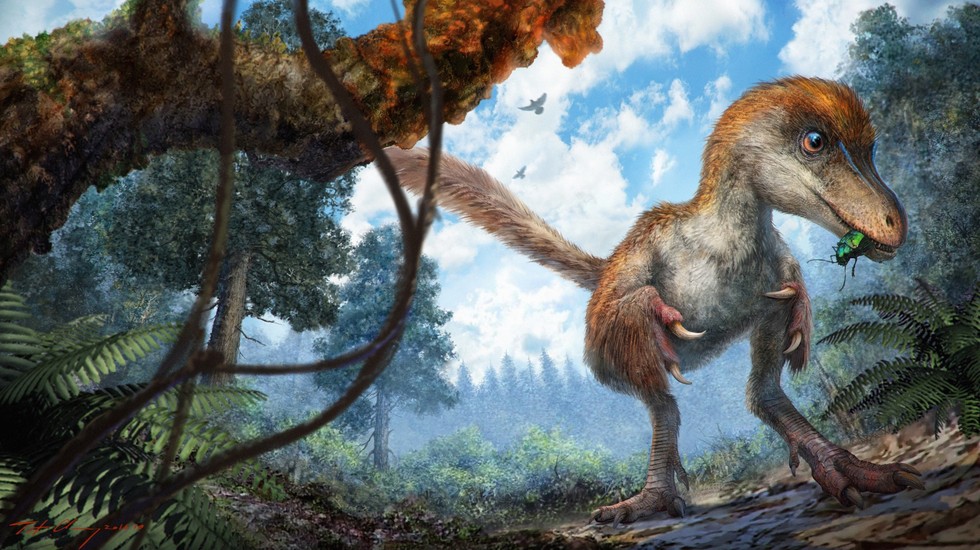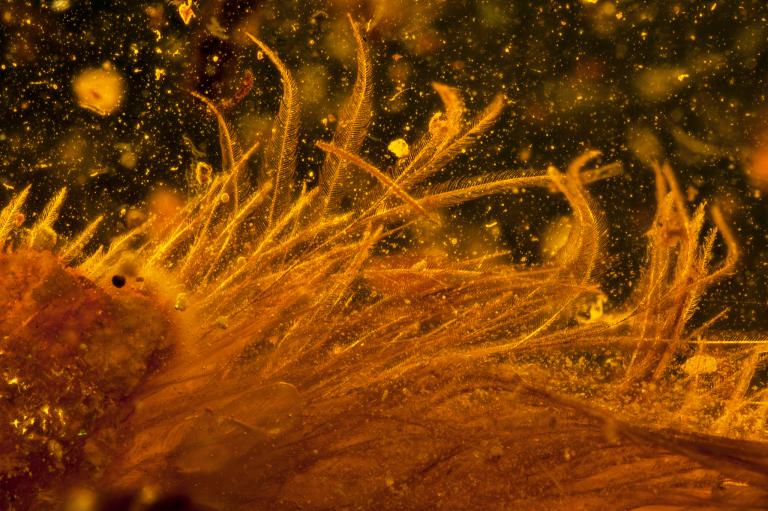Drops of fossilized tree resin valued not only for its Golden beauty, but also for those tiny creatures, which they sometimes retain in its bosom. Many of them millions of years — and thus is an invaluable source of knowledge for paleontologists.
But one piece of amber discovered by scientists not so long ago on the market in Myanmar, it was really a rare treasure: it remained part of the feathered tail. The latter belonged to a small bipedal dinosaur that lived about 99 million years ago.
the Discovery is indeed unique because paleontologists didn’t think to look in amber’s remains of ancient dinosaurs. Now, however, scientists have a valuable piece of amber with a part of the ancient lizard inside that will help look into the early evolution of feathers of these animals.

According to another paleontologist and entomologist Michael Engel (Michael Engel) from the University of Kansas, amber is remarkably useful as it allows you to learn a lot about ancient creatures and plants. “He accurately preserves objects,” he says. For example, rocks often provide researchers with only the imprint of the skeleton of the animal, often highly deformed, and the amber keeps miniature creatures and often even completely “catches them” in the process of some action. So basically, they can sue not just about appearance, but about the way of life of an ancient being.
Although, of course, quite hard to find in amber of large animals, when trapped in sticky resin flux. Nevertheless, it happens: for example, once scientists have discovered the oldest amber in the world of a chameleon and as many as 11 of the ancient lizards. Is that also luck and with the remains of ancient plants.
the amber deposits found in the North of Myanmar, contain some of the most diverse “sets” of remains of animals of the Cretaceous period. Paleontologist Lida Xing (Lida Xing) of Chinese University of Geosciences in Beijing literally hunting for an important content of ancient resins in the markets of Myanmar. For example, he had previously found two well-preserved tiny wing of the dinosaur era. Lucky this time, the scientist stumbled upon the amber that contained the 3.6-inch piece of feathered tail.

Shin turned to the paleontologist Ryan McKellar (Ryan McKellar) from Royal Saskatchewan Museum in Canada. The researchers made a series of photographs with a microscope and computer tomography to study eight vertebrae and feathers (this combination of techniques has allowed a detailed study of the found object from all angles).
unlike the vertebrae of Archaeopteryx (ancient beings that, according to many scientists, was one of the early birds) or modern birds, found the vertebrae were not combined into a single one-piece rod on the tip of the tail. Instead, the tail, found in the amber was igotyoubabe and flexible, shibahime in several places at the same time.
According to the researchers, these results suggests that the owner of the tail was not a bird, and was a real dinosaur, and most likely ancient dinosaurs belonged to the group of small two-legged creatures called coelurosaurs.
the Researchers studied preserved fossilized structure, in ancient times contained the pigments that give feathers colour, and concluded that the theropod had a chestnut-brown color in the upper part of the tail, and its “wrong side” were a bit lighter. Amber has also allowed researchers to study the structure of the tail of the animal in the scope.
the Feathers of modern birds has a Central rod or “rachis”, which branched into a number of drifts, and they, in turn, again disintegrate into thin bartocci. But the found sample of “rakhis” relatively thin and flexible compared with the thick and rigid Central core in the tails of modern birds.
meanwhile, the structure of brodock quite complex with subtle rows of branches, as in modern birds. In General the structure of the plumage suggests that the animal was not capable of flight, says McKellar.

Holtz agree with the conclusions of another scientist. The animal probably could not fly, he says, noting that the discovery confirms another conclusion: most likely, feathers evolved not for flight (or for him), and for example, to keep the heat or have served to attract partners for mating.
a Description of an extraordinary “tail” of the findings of paleontologists, published in the journal Current Biology.
No comments:
Post a Comment